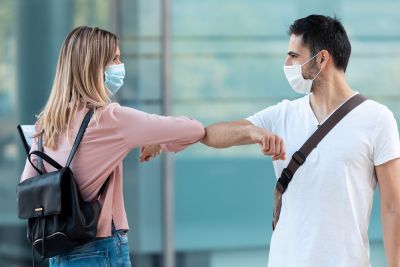Just one year after the World Health Organization declared the novel coronavirus a global pandemic, three COVID-19 vaccines are available in the United States, and more than 2 million Americans are receiving shots each day. Americans are eager to get back to business as usual, but experts caution that opening the economy prematurely could allow a potential resurgence of the virus. How foot traffic patterns in restaurants and bars, schools and universities, nail salons and barbershops affect the risk of transmission has been largely unknown.
In an article published in npj Digital Medicine, researcher-physicians from Beth Israel Deaconess Medical Center (BIDMC) used anonymized cell-phone data to build a Business Risk Index, which quantifies the potential risk of COVID-19 transmission in these establishments. The team's index accounts for both the density of visits and the length of time individuals linger inside, providing a more precise description of the human interactions -- and thus risk of viral transmission -- going on inside.
"While business traffic pre-pandemic and during statewide shut downs has been studied, business foot traffic and its relationship to COVID-19 transmission in the so-called 'new normal' of re-opening has not been well understood." said corresponding author Ashley O'Donoghue, PhD, an economist in the Center for Healthcare Delivery Science at BIDMC. "Many forecasting models use anonymized cell-phone mobility data as a broad measure of the movement of residents. But two regions with same levels of mobility will likely see very different levels of COVID-19 transmission if people in one region are diligently practicing social distancing and people in the other are not."
O'Donoghue and colleagues built their risk index by analyzing trends in foot traffic patterns in more than 1.25 million businesses across eight states from January to June 2020. In the six New England states, New York and California, the team saw a 30 percent drop in high-density foot traffic and long visit lengths to businesses -- two factors that can increase the risk of COVID-19 transmission -- from the pre-pandemic baseline to April 2020. They saw similar declines when they looked at similar risky foot traffic patterns in restaurants, bars, universities and personal care establishments (which includes hair and nail salons and barbershops). In both analyses, the risk index rose steadily starting in mid-June as states eased restrictions.
Next, using county-level COVID-19 data for the same time period, the team demonstrated that their index could accurately forecast future COVID-19 cases with a one-week lag. The team found that an increase in a county's average Business Risk Index was associated with an increase in COVID-19 cases per 10,000 people in one week.
"Not all types of mobility contribute equally to increased risk of transmission, so it is important to directly measure human interaction when weighing the costs and benefits of reopening and lifting restrictions on businesses," said senior author Jennifer P. Stevens, MD, MS, director of the Center for Healthcare Delivery Science at BIDMC. "Tracking how individuals use different businesses may provide the kind of information policymakers need to re-open different businesses in the safest way possible."
O'Donoghue, Stevens and team are now building an online decision-support tool that will help policymakers and hospital decision-makers monitor weekly risk in their areas. They have also deployed a prototype of their tool for Massachusetts that is being used by a large tertiary academic medical center in Boston to monitor potential surges in their service area, and their index has been integrated as a feature in a forecasting model for a large health system in Massachusetts.
"Our index can better quantify close human interactions, which are important predictors of transmission and help identify potential disease surges," said Stevens.
Source: Beth Israel Deaconess Medical Center

Be the first to comment on "Researchers Model a ‘Safe New Normal’"